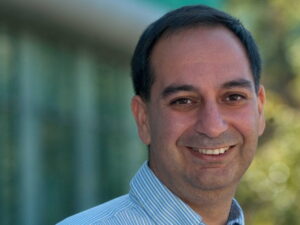UCI professor of developmental and cell biology seeks answers to how genes are regulated
by Matt Coker, UCI | April 4, 2022

“My interest is in understanding how our DNA regulates when our genes are turned on and off in different tissues and how this genetic program is executed during development and disease,” says Ali Mortazavi, UCI professor of developmental and cell biology. Steve Zylius / UCI
Ali Mortazavi’s research has been fundamental to understanding changes in gene expression in colon cancer, Lyme disease, breast cancer, Alzheimer’s and other neurological diseases, as well as to subsequent translational efforts. But saving lives is not what motivates the professor of developmental and cell biology in UCI’s School of Biological Sciences.
“I’m very gratified that my work on measuring gene expression using RNA sequencing has led to people having their lives saved, but it’s not why I do it,” Mortazavi says. “I do it because I want to answer some of the fundamental questions about how life works at the level of how genes are regulated. I do it because it’s thrilling. It’s more addictive than anything you can imagine.”
His focus is known as transcriptional regulation, although it can also be categorized as regulatory biology. “My interest is in understanding how our DNA regulates when our genes are turned on and off in different tissues and how this genetic program is executed during development and disease,” Mortazavi says.
At conception, a father contributes 3 billion base pairs of DNA, and a mother contributes 3 billion more. Each strand of DNA is encoded with genetic information that unlocks an individual’s visible and internal differences, from height and eye color to preferences and susceptibility to certain diseases.
“One of the long-term goals has been to understand which base pairs lead to those attributes,” Mortazavi says. “We don’t think all information in those billions of base pairs is equally important, and we’re just trying to figure out which ones are and which ones are not.”
What makes you “you” is not what first interested him as he pursued a Ph.D. in biology at the California Institute of Technology, which was preceded by a bachelor’s degree in engineering and applied science at Caltech as well as a master’s in biochemistry at California State University, Los Angeles.
“Before I went back to Caltech, I was fascinated with how much I have in common with my dog,” Mortazavi says. “Clearly, there were lots of things in common, and clearly, there were lots of things my dog was going to be able to do that I couldn’t and vice versa. And that was all encoded in our genes, so I wanted to know that.”
Finding answers to the fundamental questions his research raises often involves the study of mice, which are the main animals used in biomedical life sciences.
“You would never test a medical drug on a human before you test on a mouse,” Mortazavi says. “If you want to figure out how to cure Alzheimer’s disease, you first must figure out how to get Alzheimer’s disease to happen in a mouse, which is extremely difficult. Once you have a good model of Alzheimer’s disease in the mouse, then you can also figure out whether a therapy is going to work there or not.”
Calling our DNA “a very complicated software system that the cells in our body use to run everything,” he says, “Comparing a mouse and a human is like comparing MacOS to Windows or iOS to Android to figure out what they have in common and what is specific to each.”
The National Institutes of Health’s National Human Genome Research Institute is providing $185 million in grants for research on the impact of genomic variation on function, including a $12 million grant for the study of mouse genomic variation in Mortazavi’s lab.
He also collaborates in the research of others at UCI, including Distinguished Professor Tallie Baram’s long-term study on how early-life adversity can affect people decades later and evolutionary biologist Aide Macias-Munoz’s recent paper on how hydras regenerate their heads.
Published in December in Genome Biology and Evolution and quickly picked up by outlets ranging from The Scientist to The New York Times, “Coordinated Gene Expression and Chromatin Regulation During Hydra Head Regeneration” pinpoints the genetic machinery behind some of the tiny creature’s amazing restoration powers.
“The opportunities to collaborate are amazing at UCI,” Mortazavi says, citing the campus’s expansion into precision medicine using genomics. “I’m on these Alzheimer’s disease projects or these muscular dystrophy things or multiple breast cancer papers. They’ve expanded my view of the world. I was interested in these fundamental questions, and because of those collaborations, I have a chance to see how that plays into socially important diseases.”
He adds: “The common thread on everything I do in my life in the lab is how these genes are regulated by other genes and how these things are encoded in the DNA and how this network of genes regulates this other network of genes that regulates a third network of genes. You can think of these gene regulatory networks as blueprints of what’s regulated in the genome. What I’m working on I will probably continue until someone can take a sample of an infant’s DNA and draw a sketch of what that person will look like at age 25. Obviously, it won’t predict everything, but we should be able to predict all of the traits that identical twins would share. So I think I’m going to be working in this area forever. And to treat diseases, that’s going to be the next big thing. It’s thrilling to study genomics at UCI in what is sure to be the field’s golden age.”
